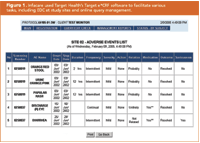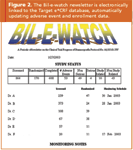Example of an Industry-CRO Partnership
Applied Clinical Trials
Target Health and Infacare used a CRF database to answer all of FDA's questions.
Elevated plasma bilirubin (hyperbilirubinemia jaundice) may be found to some degree in about 60% of all neonates. In a small group of these children, it may progress to a serious neurological problem termed "kernicterus." Prevention of kernicterus has recently become a public health initiative by the Centers for Disease Control and Prevention. It is under consideration for such designation by the Joint Commission of Accreditation of Hospital Organizations. In April of 2001, a Sentinel Event Alert was issued on the risk of kernicterus.
In conjunction with a diagnostic device that can painlessly measure bilirubin though transcutaneous photometry, and a recently developed predictive nomogram that can determine which babies might be predisposed to dangerously elevated bilirubin levels, a drug is under development that can reduce bilirubin levels in at-risk babies. This drug, Stanate, was discovered by Attallah Kappas, MD, at Rockefeller University, acquired by WellSpring Pharmaceutical Inc., and licensed to Infacare Pharmaceutical, Inc. To optimize clinical development, Infacare chose CRO Target Health Inc. for its electronic case report form (eCRF) and study management software (Figure 1).

Figure 1. Infacare used Target Health's Target e*CRF software to facilitate various tasks, including EDC at study sites and online query management.
The primary aim of the collaboration was to develop a program to capture data electronically instead of by the traditional paper method. This approach provided several advantages. First, data management was combined with data entry in a seamless up-front procedure, instead of being segmented between two different departments. Second, internal computerized control created validated edit checks that reduced data entry errors significantly. Third, a validated database was available in real time for internal and regulatory reporting, and for tracking overall and individual site study progress. Finally, electronic data capture over the Internet provided both data capture and study management capability without the need of downloading software at each study site. All data management and study changes were made on the server so that all study sites were synchronized with regard to protocol conduct.
An extra feature of the program was developed through use of an ancillary newsletter, titled Bil-e-watch (Figure 2). Bil-e-watch was automatically linked to the eCRF database. As a result, information on adverse events and enrollment was automatically updated to all study sites and management on a regular basis. Bil-e-watch kept management updated in a real-time basis with study progress and allowed investigators to be immediately aware of any potential safety issues.

Figure 2. The Bil-e-watch newsletter is electronically linked to the Target e*CRF database, automatically updating adverse event and enrollment data.
Results
The sponsor's clinical research associates (CRAs) worked closely with the CRO in a seamless operation to develop the eCRF application. There were four reasons for an immediate cost savings of 30% from a paper trial since:
1) There was no need to print CRFs and ship them to the study sites.
2) Double-key data entry was avoided.
3) The number of queries was reduced by over 50%.
4) Time and money were saved because the queries were handled electronically in a fraction of the time normally spent for a paper system.
The system also provided a cost-effective tool to monitor subject enrollment without having to receive reports directly from the sites. Since this was a hospital-based study, the sponsor arranged for the hospital pharmacist to enter via the Internet the amount of drug dispensed.
As a result, the sponsor knew exactly when each baby was randomized and whether the dose was given correctly. Also, as the pharmacist entered the dosing data, an automatic alert system was set up to report via email any dosing errors. In comparison with a paper CRF-based clinical trial, this process provided an immediate alert to any possible dosing errors, which allowed for corrective action prior to any monitoring visit. The cost of one protocol violation was estimated to be $3000, and there were lots of controls to minimize this possibility.
The Medical Director reviewed the drug safety via online customized reports on a weekly basis, and shared it with the sponsor and the members of the data safety monitoring board (DSMB). Early and unexpectedly in the study, the FDA requested that an interim analysis of the safety and efficacy data be presented to its Advisory Panel. In order to prepare for the meeting, the team immediately convened to review the request and came up with a plan.
Fortunately, because of the Internet-based trial, 70% of the data were already in the database at the time of the FDA's initial request. Then, over the course of six weeks, several parallel tracks were established to prepare for the FDA meeting. The sponsor's CRAs went to the study sites to perform source document review and verification. The CRO arranged for the DSMB meeting to review the safety and efficacy data. And the CRO prepared for the statistical analysis.
Usually this process can take about six months. Instead, it took six weeks. Because of the rush to meet the FDA deadline, it would have cost the sponsor a minimum of $30,000 for a rush job. Six weeks after the FDA request, the data were presented to the DSMB for their review. By using an Internet-based clinical trial and a CRO, the sponsor was able to meet all of the deadlines and meet with FDA, data in hand. Also, by using this approach, millions of dollars of both direct and opportunity costs were saved, with minimal wasted efforts.
Infacare Pharmaceuticals was so pleased with the performance of the eCRF that the CRO was asked to develop an Internet-based document management and viewing system. The document system was to be built for an international "compassionate use" clinical trial for Stanate in newborns for whom exchange transfusion was indicated.
It was not financially or operationally realistic for the sponsor to send CRAs all over the world to identify study sites, and then to send the confidentiality agreement, protocol, investigator brochure, and sample informed consent form via overnight courier. The sponsor did not have the resources to execute and track all of this. The document system allowed the sponsor to have one person manage the entire study startup process, worldwide.
It was estimated by the sponsor that the overall savings would be over $100,000, but more importantly, the study could be managed with minimal effort, resulting in additional revenue to the sponsor of approximately $500,000. In addition, the sponsor was able to reduce the number of people involved in data management. Their CRAs became the focus of the program at the front end of the operation, instead of at the back end, which is how it works with "paper" CRFs.
The document system works as follows: The system administrator creates a study and assigns documents to the study. Since the sponsor makes sure that the versions are correct, no one can say that they had the wrong copy of a document. When an investigator registers for the protocol, he/she electronically signs a confidentiality agreement. The sponsor then reviews the registration online and considers whether the qualifications of the applicant are equal to the job. Once an investigator is approved, access is provided to all of the documents needed to support the Ethics Committee review process. Once the sponsor receives the Ethics Committee approval, drug is shipped. The CRFs are also online and easily accessible to the study site. All they have to do now is treat the newborn baby and submit the study results.
Conclusions
The automation of the clinical trial process via the Internet is dramatically changing the way the pharmaceutical industry manages clinical trials. While the cost savings are a significant factor in deciding whether to use this technology, the fact that data can be viewed in real time is a huge advantage. For the present study, by reducing the time from data entry to data analysis, Infacare Pharmaceuticals was able to streamline the drug development process and facilitate decision-making.
Benjamin Levinson is vice president, drug development with Infacare Pharmaceutical Corporation, Inc., 1430 State Route 34, Neptune, NJ 07753.
Jules T. Mitchel is president of Target Health Inc., 261 Madison Ave., 24th Floor, New York, NY 10016, (212) 681-2100, fax (212) 681-2105, email: julesmitchel@targethealth.com.
*To whom all correspondence should be addressed.

Improving Relationships and Diversifying the Site Selection Process
April 17th 2025In this episode of the Applied Clinical Trials Podcast, Liz Beatty, co-founder and chief strategy officer, Inato, discusses a number of topics around site engagement including community-based sites, the role of technology in improving site/sponsor relationships, how increased operational costs are impacting the industry, and more.